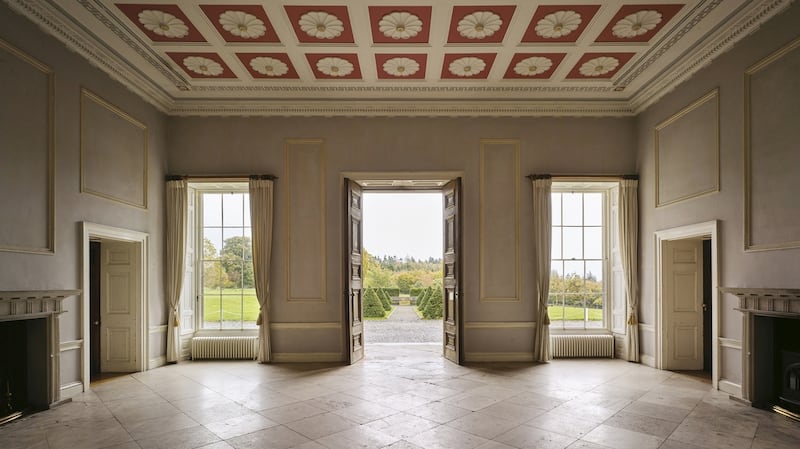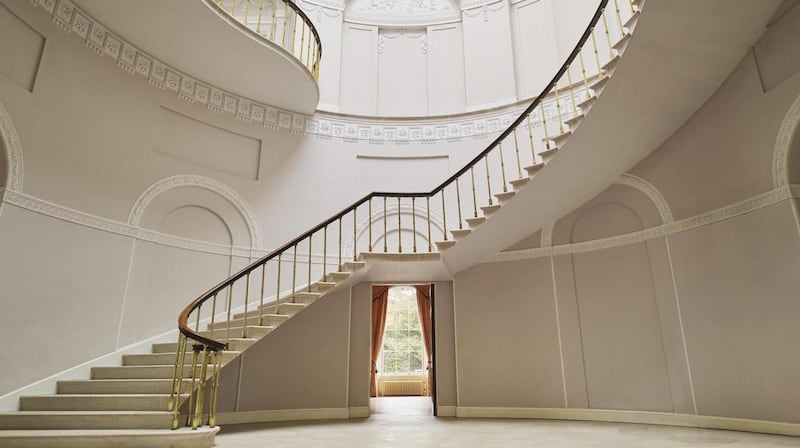Francis Johnston was the most prolific Irish architect of his generation, designing such remarkable works as the Chapel Royal in Dublin Castle, the GPO and Nelson's Pillar on Sackville (O'Connell) Street, and St George's Church with its triple-tiered steeple in Hardwicke Place. But his masterpiece is the lesser-known Townley Hall, a neo-classical mansion standing on high ground in the Boyne Valley, 5km from Drogheda.
Built in 1798 for local landowner Blaney Townley Balfour, his Fermanagh-born wife Florence and their nine children, the house is a perfect square, 90ft (27.4 metres) long on each side, with a central rotunda topped by an oculus that’s 15ft (4.6 metres) wide.
“There is nothing lovelier in the Georgian architecture of these islands than the rotunda and staircase at Townley Hall”, noted Country Life magazine in 1948.


Now the house and its history are being celebrated by a large-format book, published by Gandon Editions for the School of Philosophy and Economic Science, the current occupiers of Townley Hall. It’s their “gift . . . in appreciation for the generosity which enabled us to acquire such a magnificent building”, explains David Horan, current head of the school in Ireland, in his foreword entitled “Beauty, Symmetry and Truth”.
Three fascinating scholarly essays by architectural historian Robert O'Byrne recount the Townley Balfour family's history in the area; the commissioning of Francis Johnston to design Townley Hall – replacing an earlier, much smaller house – and how it was passed down through several generations, before being purchased by Trinity College in 1956 and later used as a base for archaeological excavations at Knowth.
From 1957 onwards, Francis Johnston’s great Greek revival mansion was lived in by the renowned naturalist Prof Frank Mitchell, his wife Lucy (“Pic”) and their two daughters, while it was being run as a study centre. Ten years later, Mitchell bought the house and some 60 acres of parkland around it, eventually retiring after Pic’s death to a “gardener’s cottage” on the estate. He died in 1997, at the age of 85.
The School of Philosophy and Economic Science, whose interests range from the dialogues of Plato, to the teachings of Indian guru Adi Shankara, and transcendental meditation, had been using Townley Hall as a retreat centre. The school agreed to purchase it from Frank Mitchell in a most unusual way, paying for the property in annual instalments of £25,000 throughout the 1980s. This was seen as “a gift from the gods”.
Townley Hall is not generally open to the public. "We have tried over the years, through public events organised by the school and third parties, to make it available to the broader community. Indeed, we recognise that we have a responsibility as custodians in that respect", says Dermot Conway, who runs it on behalf of the school. "We are planning to have, say, four open days throughout the year that people can pre-book".
Since 2015, the school has invested nearly €1.5 million in renovating the once-derelict kitchen wing at the rear, adding a minimalist zinc-clad lift and bedroom floor. "That couldn't have been done in the house itself because it would have been too invasive", says architect Michael Kavanagh of MVK Architects, a major contributor to the book. "It's been a bit unnerving at times. We wouldn't have wanted to do anything that would clash with [Francis] Johnston's intentions."
Even though he knows Townley Hall like the back of his hand, one can sense that Kavanagh is still in awe at Johnston’s achievement. He sees its “beautiful fluidity”, centred on the rotunda, with grand rooms on the ground floor opening off it and leading into each other, all but eliminating the need for corridors. And while the house appears to be only two storeys high, in fact it’s four, including the basement and attic floor.
The Greek revival inspiration is most pronounced in its entrance hall, with an elaborate coffered ceiling fringed by a cornice in the Greek key pattern, and a pair of Doric fireplaces made from local limestone. Sadly, as Kavanagh says, “not a stick of original furniture” or pictures from Townley Hall, so lushly depicted in the Country Life feature from 1948, survived in situ. But that’s true of so many stately homes in Ireland.
The cantilevered Portland stone staircase was made in England, shipped over and assembled in the rotunda, with gleaming brass balusters and an elegant handrail, beneath a coffered dome that is a brilliant visual exercise in geometry. The Portland floor is also paved in a geometric pattern, best seen from above. Overall, the effect is quite breathtaking and would have dazzled visitors over the past two centuries.
Original panelled doors are all Cuban mahogany, so a new door leading to the kitchen wing was made from the same timber, replicating Johnston’s design; the ornate library door stands out, as it was copied from the Erechtheion, an ancient Greek temple in Athens. Unusually, all sash windows have folding shutters with four hinges – except for four on the front elevation that are false: they appear to be windows, but there’s a solid wall behind.
Apart from dealing with every aspect of Townley Hall, Gandon Editions’ John O’Regan “encouraged us to explore the Johnston angle, as there had been nothing major published about him for decades”, says Dermot Conway. As a result, the book includes a biography of Johnston by Michael Kavanagh, and a 45-page illustrated catalogue of all his work between 1775 and 1829, which is a revelation in itself.
Compiled in collaboration with the Irish Architectural Archive, it covers numerous country houses, including the Gothic Revival-style Charleville Castle, near Tullamore (1812), as well as nine "lunatic asylums" (as they were called then), the conversion of the old parliament on Dublin's College Green into Bank of Ireland (1808), and the embellishment with neo-classical porticos of what is now Áras an Uachtaráin.
Townley Hall: Francis Johnston’s Neo-Classical Masterpiece will be published by Gandon Editions on March 31st, price €40.






